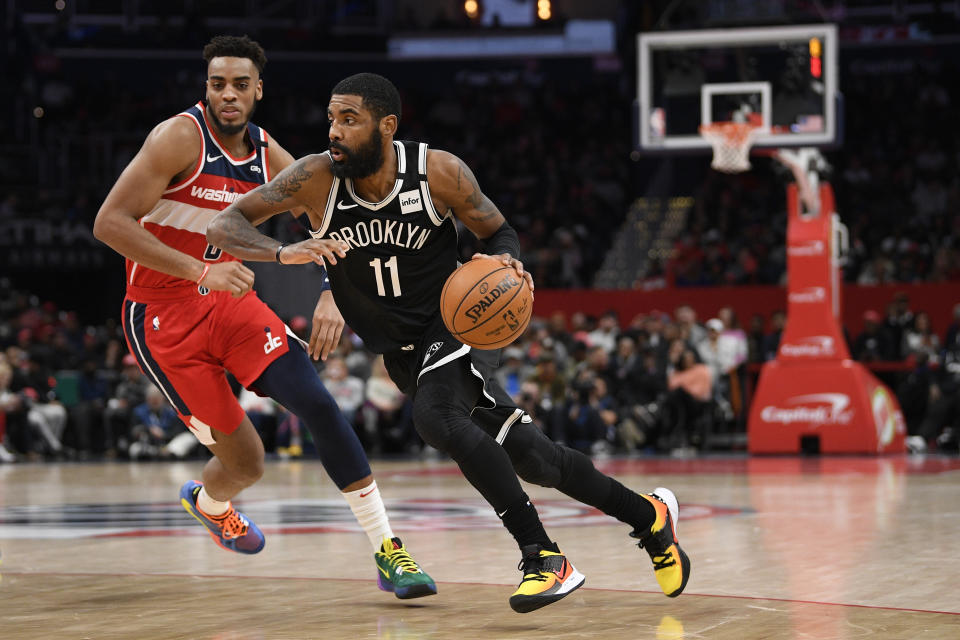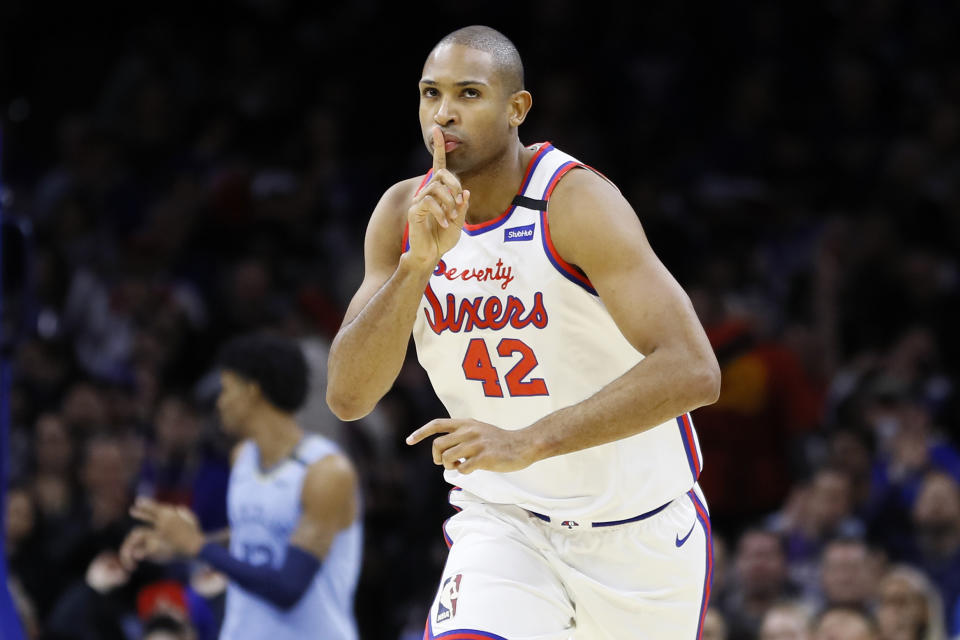Checking in on the biggest NBA moves of the summer, Part II
Rating the biggest moves, Part I
The NBA saw a lot of change this past summer — so much so that we needed two parts to break down the major moves. Here are the rest of the big transactions that framed this season, with pass-fail grades.
Kyrie Irving and Kevin Durant to the Brooklyn Nets
Durant and Irving kicked things off pretty early in free agency. It was a fairly open secret that Irving was leaving Boston by the time the 2019 playoffs started. Durant’s situation was a lot more nebulous, but seemed to crystallize after he tore his Achilles tendon in the NBA Finals. Durant signed a four-year, max deal with the Nets at a total of just over $164 million. Irving also inked a max deal at $136.5 million over four years. Both players have player options on the final season of their deals in 2022-23.
The challenge for the Nets is that these deals were basically about the 2020-21 season and beyond. Durant has always been slated to miss the entire season. That makes his half of the equation an unknown. While Brooklyn and Durant both seem optimistic he’ll make a full recovery, the reality remains that Durant will be 32 years old the next time we see him on the basketball court. And the list of players to come back from Achilles tears to recapture their old form is a very short one.

As for Irving, his first season in Brooklyn has been up and down. He appeared in only 20 of the Nets’ 53 games and will miss the remainder of the season after having shoulder surgery. When he did play, Irving was great for Brooklyn, averaging 27.4 points, 6.4 assists and 5.2 rebounds.
Still, it wouldn’t be Kyrie Irving without some level of controversy. Just as he did with the Boston Celtics, Irving called out some teammates and their ability to contribute to a title contender next season. By listing some names and not others, Irving made it clear who he sees joining himself and Durant on next year’s Nets.
Lastly … the Nets are a worse team than a year ago. Last year through 53 games, Brooklyn was 28-25. This year, they are 25-28. GM Sean Marks spent years digging out of a salary-cap mess and identifying undervalued talent. Adding Irving and Durant was a major gamble and in the short-term hasn’t paid off. Long-term results are awaited with bated breath.
Nets: Fail, but it was never really about this year.
Golden State Warriors acquire D’Angelo Russell via sign-and-trade from the Brooklyn Nets
When Brooklyn had an agreement with Kevin Durant, Golden State acted quickly to make sure it didn’t lose Durant for nothing. The Warriors worked out a double sign-and-trade to swap Durant for fellow free agent D’Angelo Russell. The thought was to recoup an asset in the form of a young player, while also getting some immediate on-court help. With Klay Thompson recovering from a torn ACL suffered in the NBA Finals and Durant off to the Nets, the Warriors needed someone to provide some scoring punch alongside Stephen Curry.
Oh, the best laid plans of mice and men. Curry was hurt in the fourth game of the season, Draymond Green has been banged up, other rotation players have missed time, Thompson is still out, and Russell was traded to the Minnesota Timberwolves at the deadline. It’s been that sort of year for the former powerhouse.
It’s not that Russell didn’t play well in his 33 games for Golden State. He gave them scoring, if somewhat inefficiently, and playmaking. But there were concerns about his long-term fit when Curry and Thompson return.
With the season a disaster and the chance for the Warriors to fully reset, they swapped Russell for Andrew Wiggins. While an inconsistent enigma, Wiggins at least fits the team better positionally. And the hope is that surrounded by better talent, maybe Wiggins will finally blossom. But the question has to be asked: This is the best Golden State could do?
Warriors: Fail
Boston Celtics acquire Kemba Walker via sign-and-trade from the Charlotte Hornets
On the other side of the country, Irving choosing to team up with Durant in Brooklyn left a hole at point guard for Boston. The Celtics immediately moved on and agreed to add Kemba Walker from Charlotte. Rather than do a straight signing, Boston was able to work another double sign-and-trade agreement to acquire Walker for Terry Rozier. The plan was to be able to re-sign Al Horford as well, but more on that later.
Like Irving and Isaiah Thomas before him, Walker has excelled in coach Brad Stevens’ point guard-friendly offense. Walker was a starter in the All-Star Game and is a huge part of Boston’s perimeter attack. Because of his ability to play off the ball and his “happy to be here” attitude, Walker has been a perfect fit as a leader for the Celtics young roster.
Celtics: Pass

Al Horford to the Philadelphia 76ers
As Boston was working to add Kemba Walker, the Sixers slipped in and signed Al Horford to a four-year, $109 million contract. The final year of that contract is only guaranteed for $14.5 million, but can escalate up to $26.5 million, depending if the 76ers make and/or win the NBA Finals.
The reason the 76ers were willing to add those escalators is that you happily pay for a champion. The hope was that by super-sizing its lineup as the rest of the league downsizes, Philadelphia would have a decided advantage.
As we come out of the All-Star break, that plan hasn’t worked as hoped. The Sixers are fifth in the Eastern Conference, and Horford was sent to the bench right before the break. The big lineups haven’t worked. The spacing is messy and the offense can’t find room to create good looks. That’s led to Horford being moved to the bench in Year One of his $100 million deal.
The consistent spin is that this team was built to win in the postseason, but that looks doubtful.
76ers: Fail
Miami Heat acquire Jimmy Butler via sign-and-trade with the Philadelphia 76ers
Part of the way Philadelphia created the cap space to sign Al Horford was by sending Jimmy Butler to Miami via sign-and-trade for Josh Richardson. Butler’s fit seemed to work for the Sixers, but he made it clear he wanted to be with the Heat as soon as free agency began. Miami had no real way to acquire Butler directly, but worked an agreement to take on some salary from Portland, while sending Richardson to Philadelphia and Hassan Whiteside to the Trail Blazers.
That move has worked out wonderfully for the Heat. Butler has been an instant fit within the culture Pat Riley and Erik Spoelstra have cultivated in South Beach. He’s led Miami to a sure playoff spot and has the Heat in the mix for home-court advantage in the first round.
Richardson has been nicked up and is a small part of the clunky offensive fit. This side of the trade still has a lot to be decided. We’re giving the Sixers the benefit of the doubt here, as they are trying to figure out the fit issues and Richardson has largely been pretty good.
Heat: Pass
76ers: Pass
Indiana Pacers acquire Malcolm Brogdon via sign-and-trade with the Milwaukee Bucks
After years of being conservative with their contracts, the Pacers spent big to bring in Malcolm Brogdon. Indiana lured the point guard away from division rival Milwaukee with a four-year, $85 million contract. Given Brogdon’s restricted free-agent status at the time, the Pacers and Bucks agreed to forgo the offer sheet process and instead agreed to a trade in which Indiana sent Milwaukee a first-round pick.
Despite some injury issues, Brogdon has been good for Indiana. His shooting is down from a 50/40/90 season a year ago, but that seems to be related to Brogdon being a primary scorer instead of a supporting player. Now that Victor Oladipo is back, Brogdon should be able to go back to being a secondary option on the offensive end. The hope is that Brogdon and Oladipo will present a backcourt in which both players are equally adept at attacking off the bounce, while being shooting weapons as well.
As for Milwaukee, it’s hard to say it’s missed Brogdon much at all. The Bucks are 46-8 and have a historic scoring differential. Maybe Brogdon’s absence will be felt more in the playoffs, when teams can use another offensive creator. For now, Milwaukee hasn’t missed a beat.
Pacers: Pass
Bucks: Pass
More from Yahoo Sports:

 Yahoo News
Yahoo News 
